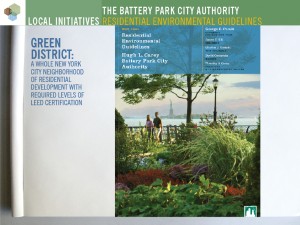

Project Profiles
Battery Park City Authority Guidelines
Chris Garvin
Share
Learn more about our environmental strategy work and services by emailing us at [email protected]. Follow the conversation on twitter: @TerrapinBG.
The Residential, Commercial, and existing building Environmental Guidelines for Battery Park City – a 92 acre planned community on the west side of lower Manhattan – have provided a foundation for many innovative ideas that improve the urban experience and provide a vision of what cities can become. The purpose for the guidelines grew out of a desire to respond to increased public awareness of environmental conservation and increased demand for healthier, high quality living and working environments. Bob Fox and Bill Browning worked with The Battery Park City Authority (BPCA), Atelier Ten, Camroden Associates, COOKFOX Architects, Flack + Kurtz, NYSERDA, Steven Winter Associates, and Sustainable Energy Partnerships to set a new “green” standard for New York City, based on a very early version of the LEED Rating System but tailored to the specifics of New York City. The guidelines became a local model for healthy, ecologically responsible environments and were responsible for the creation of the first “green” residential tower in the United States, The Solaire.
The guidelines focus on five major categories or requirements. Energy Efficiency standards included a high-performance building envelope, thermal energy recovery, on-site power generation, and reduced energy cost. Indoor Environmental Quality (IEQ) standards focus on maximized access to daylight and outdoor views while creating interior air that is superior to the exterior by requiring air sealing, filtered apartment air, and minimized chemical infiltration of spaces. Material and Resource standards go beyond the standard “reduce, reuse, recycle” by requiring 80 percent of construction waste to be diverted from landfill and the purchase and installation of recycled, and rapidly renewable materials.
Education, Operations, and Maintenance standards included the training of construction personnel, the development of green guide for tenants, and commissioning and monitoring for all building systems. Water Conservation & Site Management standards include requirements to capture, treat, and use all rainwater from roof and terraces; reclaim, treat, and reuse “black water” from toilets and other fixtures; plant green roofs for 75 percent of roof area and the elimination of light trespass from building and site to improve night sky. As a result of these guidelines, Battery Park City has over 5 million square feet of LEED Gold and Platinum Buildings and is home to the greatest concentration of LEED Gold high-rises in the world.
*Initial phases performed by Bob Fox in affiliation with Fox & Fowle Architects and Bill Browning in affiliation with Rocky Mountain Institute.
Filed under:
Chris Garvin
As a partner, Chris is an architect and sustainability leader focused on systemic thinking to address challenges in the built environment. Chris believes we can learn how to live on this planet if we start listening to nature again.
Topics
- Environmental Values
- Speaking
- LEED
- Terrapin Team
- Phoebe
- Community Development
- Greenbuild
- Technology
- Biophilic Design Interactive
- Catie Ryan
- Spanish
- Hebrew
- French
- Portuguese
- Publications
- Occupant Comfort
- Materials Science
- Conference
- Psychoacoustics
- Education
- Workshop
- Mass Timber
- Transit
- Carbon Strategy
- connection with natural materials
- interior design
- inspirational hero
- biophilia
- economics of biophilia
- Sustainability
- wood
- case studies
- Systems Integration
- Biophilic Design
- Commercial
- Net Zero
- Resorts & Hospitality
- Energy Utilization
- Water Management
- Corporations and Institutions
- Institutional
- Ecosystem Science
- Green Guidelines
- Profitability
- Climate Resiliency
- Health & Wellbeing
- Indoor Environmental Quality
- Building Performance
- Bioinspired Innovation
- Biodiversity
- Residential
- Master Planning
- Architects and Designers
- Developers and Building Owners
- Governments and NGOs
- Urban Design
- Product Development
- Original Research
- Manufacturing
- Industrial Ecology
- Resource Management
- Sustainability Plans
- Health Care
- Carbon Neutrality



